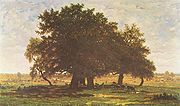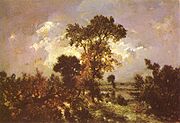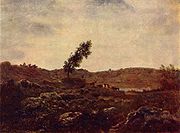
Théodore Rousseau
Encyclopedia
Pierre Étienne Théodore Rousseau (April 15, 1812 – December 22, 1867), French
painter
of the Barbizon school
, was born in Paris
, of a bourgeois family.

authorities. Théodore Rousseau shared the difficulties of the romantic painters of 1830 in securing for their pictures a place in the annual Paris exhibition. The influence of classically trained artists was against them, and not until 1848 was Rousseau presented adequately to the public.
 He had exhibited one or two unimportant works in the Salon of 1831 and 1834, but in 1836 his great work "La descente des vaches" was rejected by the vote of the classic painters; and from then until after the revolution of 1848 he was persistently refused. He was not without champions in the press, and with the title of "le grand refusé" he became known through the writings of Thoré, the critic who afterwards resided in England and wrote using the name Burger.
He had exhibited one or two unimportant works in the Salon of 1831 and 1834, but in 1836 his great work "La descente des vaches" was rejected by the vote of the classic painters; and from then until after the revolution of 1848 he was persistently refused. He was not without champions in the press, and with the title of "le grand refusé" he became known through the writings of Thoré, the critic who afterwards resided in England and wrote using the name Burger.
During these years of artistic exile Rousseau produced some of his best pictures: "The Chestnut Avenue", "The Marsh in the Landes" (now in the Louvre
), "Hoar-Frost" (now in America); and in 1851, after the reorganization of the Salon in 1848, he exhibited his masterpiece, "The Edge of the Forest" (also in the Louvre), a picture similar in treatment to, but slightly varied in subject from, the composition called "A Glade in the Forest of Fontainebleau", in the Wallace Collection
at Hertford House, London.
, but in 1848 he took up his residence in the forest village, and spent most of his remaining days in the vicinity. He was now able to obtain fair sums for his pictures (but only about one-tenth of their value thirty years after his death), and the number of his admirers increased. He was still ignored by the authorities, for while Narcisse Virgilio Diaz
was made Chevalier of the Legion of Honour in 1851, Rousseau was left undecorated at this time, but was nominated and awarded the Cross soon afterwards. He would eventually become an Officer of the Legion of Honor.
At the Exposition Universelle of 1853, where all Rousseau's rejected pictures of the previous twenty years were gathered together, his works were acknowledged to form one of the best of the many splendid groups there exhibited. But, after an unsuccessful sale of his works by auction in 1861, he contemplated leaving Paris for Amsterdam
or London
, or even New York
.
 Rousseau then suffered a series of misfortunes. His wife, who had been a source of constant anxiety for years, became almost hopelessly insane; his aged father became dependent on him for pecuniary assistance; his patrons were few. Moreoever, while he was temporarily absent with his invalid wife, a youth living in his home (a friend of his family) committed suicide
Rousseau then suffered a series of misfortunes. His wife, who had been a source of constant anxiety for years, became almost hopelessly insane; his aged father became dependent on him for pecuniary assistance; his patrons were few. Moreoever, while he was temporarily absent with his invalid wife, a youth living in his home (a friend of his family) committed suicide
in his Barbizon cottage; when he visited the Alps in 1863, making sketches of Mont Blanc
, he became dangerously ill with inflammation of the lungs; and when he returned to Barbizon he suffered from insomnia
and became gradually weakened.
He was elected president of the fine-art jury for the 1867 Exposition; however, his disappointment at being denied the better awards may have affected his health, for in August he became paralyzed. He recovered slightly, but was again attacked several times during the autumn. In November his condition worsened, and he died in the presence of his lifelong friend, Jean-François Millet
, on December 22, 1867. Millet, the peasant painter, for whom Rousseau had the greatest regard, had been much with him during the last years of his life, and at his death Millet assumed charge of the insane wife.
Rousseau's other friend and neighbor, Jules Dupré
, himself an eminent landscape painter of Barbizon, relates the difficulty Rousseau experienced in knowing when his picture was finished, and how he, Dupré, would sometimes take away from the studio some canvas on which Rousseau was laboring too long. Rousseau was a good friend to Diaz, teaching him how to paint trees, for until a certain point in his career Diaz considered he could only paint figures.
in London.
France
The French Republic , The French Republic , The French Republic , (commonly known as France , is a unitary semi-presidential republic in Western Europe with several overseas territories and islands located on other continents and in the Indian, Pacific, and Atlantic oceans. Metropolitan France...
painter
Painting
Painting is the practice of applying paint, pigment, color or other medium to a surface . The application of the medium is commonly applied to the base with a brush but other objects can be used. In art, the term painting describes both the act and the result of the action. However, painting is...
of the Barbizon school
Barbizon school
The Barbizon school of painters were part of a movement towards realism in art, which arose in the context of the dominant Romantic Movement of the time. The Barbizon school was active roughly from 1830 through 1870...
, was born in Paris
Paris
Paris is the capital and largest city in France, situated on the river Seine, in northern France, at the heart of the Île-de-France region...
, of a bourgeois family.

Youth
At first he received a business training, but soon displayed aptitude for painting. Although his father regretted the decision at first, he became reconciled to his son forsaking business, and throughout the artist's career (for he survived his son) was a sympathizer with him in all his conflicts with the Paris SalonParis Salon
The Salon , or rarely Paris Salon , beginning in 1725 was the official art exhibition of the Académie des Beaux-Arts in Paris, France. Between 1748–1890 it was the greatest annual or biannual art event in the Western world...
authorities. Théodore Rousseau shared the difficulties of the romantic painters of 1830 in securing for their pictures a place in the annual Paris exhibition. The influence of classically trained artists was against them, and not until 1848 was Rousseau presented adequately to the public.

During these years of artistic exile Rousseau produced some of his best pictures: "The Chestnut Avenue", "The Marsh in the Landes" (now in the Louvre
Louvre
The Musée du Louvre – in English, the Louvre Museum or simply the Louvre – is one of the world's largest museums, the most visited art museum in the world and a historic monument. A central landmark of Paris, it is located on the Right Bank of the Seine in the 1st arrondissement...
), "Hoar-Frost" (now in America); and in 1851, after the reorganization of the Salon in 1848, he exhibited his masterpiece, "The Edge of the Forest" (also in the Louvre), a picture similar in treatment to, but slightly varied in subject from, the composition called "A Glade in the Forest of Fontainebleau", in the Wallace Collection
Wallace Collection
The Wallace Collection is a museum in London, with a world-famous range of fine and decorative arts from the 15th to the 19th centuries with large holdings of French 18th-century paintings, furniture, arms & armour, porcelain and Old Master paintings arranged into 25 galleries.It was established in...
at Hertford House, London.
Barbizon and maturity
Until this period Rousseau had lived only occasionally at BarbizonBarbizon
Barbizon is a commune in the Seine-et-Marne department in north-central France. It is located near the Fontainebleau Forest.-Art history:The Barbizon school of painters is named after the village; Théodore Rousseau and Jean-François Millet, leaders of the school, made their homes and died in the...
, but in 1848 he took up his residence in the forest village, and spent most of his remaining days in the vicinity. He was now able to obtain fair sums for his pictures (but only about one-tenth of their value thirty years after his death), and the number of his admirers increased. He was still ignored by the authorities, for while Narcisse Virgilio Diaz
Narcisse Virgilio Díaz
Narcisse Virgilio Díaz de la Peña was a French painter of the Barbizon school.Diaz was born in Bordeaux to Spanish parents. At the age of ten, Diaz became an orphan, and misfortune dogged his early years. His foot was bitten by a reptile in Meudon wood, near Sèvres, where he had been taken to live...
was made Chevalier of the Legion of Honour in 1851, Rousseau was left undecorated at this time, but was nominated and awarded the Cross soon afterwards. He would eventually become an Officer of the Legion of Honor.
At the Exposition Universelle of 1853, where all Rousseau's rejected pictures of the previous twenty years were gathered together, his works were acknowledged to form one of the best of the many splendid groups there exhibited. But, after an unsuccessful sale of his works by auction in 1861, he contemplated leaving Paris for Amsterdam
Amsterdam
Amsterdam is the largest city and the capital of the Netherlands. The current position of Amsterdam as capital city of the Kingdom of the Netherlands is governed by the constitution of August 24, 1815 and its successors. Amsterdam has a population of 783,364 within city limits, an urban population...
or London
London
London is the capital city of :England and the :United Kingdom, the largest metropolitan area in the United Kingdom, and the largest urban zone in the European Union by most measures. Located on the River Thames, London has been a major settlement for two millennia, its history going back to its...
, or even New York
New York
New York is a state in the Northeastern region of the United States. It is the nation's third most populous state. New York is bordered by New Jersey and Pennsylvania to the south, and by Connecticut, Massachusetts and Vermont to the east...
.
Later years

Suicide
Suicide is the act of intentionally causing one's own death. Suicide is often committed out of despair or attributed to some underlying mental disorder, such as depression, bipolar disorder, schizophrenia, alcoholism, or drug abuse...
in his Barbizon cottage; when he visited the Alps in 1863, making sketches of Mont Blanc
Mont Blanc
Mont Blanc or Monte Bianco , meaning "White Mountain", is the highest mountain in the Alps, Western Europe and the European Union. It rises above sea level and is ranked 11th in the world in topographic prominence...
, he became dangerously ill with inflammation of the lungs; and when he returned to Barbizon he suffered from insomnia
Insomnia
Insomnia is most often defined by an individual's report of sleeping difficulties. While the term is sometimes used in sleep literature to describe a disorder demonstrated by polysomnographic evidence of disturbed sleep, insomnia is often defined as a positive response to either of two questions:...
and became gradually weakened.
He was elected president of the fine-art jury for the 1867 Exposition; however, his disappointment at being denied the better awards may have affected his health, for in August he became paralyzed. He recovered slightly, but was again attacked several times during the autumn. In November his condition worsened, and he died in the presence of his lifelong friend, Jean-François Millet
Jean-François Millet
Jean-François Millet was a French painter and one of the founders of the Barbizon school in rural France...
, on December 22, 1867. Millet, the peasant painter, for whom Rousseau had the greatest regard, had been much with him during the last years of his life, and at his death Millet assumed charge of the insane wife.
Rousseau's other friend and neighbor, Jules Dupré
Jules Dupré
Jules Dupré , French painter, was one of the chief members of the Barbizon school of landscape painters. If Corot stands for the lyric and Rousseau for the epic aspect of the poetry of nature, Dupré is the exponent of her tragic and dramatic aspects.Dupré exhibited first at the Salon in 1831, and...
, himself an eminent landscape painter of Barbizon, relates the difficulty Rousseau experienced in knowing when his picture was finished, and how he, Dupré, would sometimes take away from the studio some canvas on which Rousseau was laboring too long. Rousseau was a good friend to Diaz, teaching him how to paint trees, for until a certain point in his career Diaz considered he could only paint figures.
Work
Rousseau's pictures are always grave in character, with an air of exquisite melancholy. They are well finished when they profess to be completed pictures, but Rousseau spent so much time developing his subjects that his absolutely completed works are comparatively few. He left many canvases with parts of the picture realized in detail and with the remainder somewhat vague; and also a good number of sketches and water-color drawings. His pen work in monochrome on paper is rare. There are a number of good pictures by him in the Louvre, and the Wallace collection contains one of his most important Barbizon pictures. There is also an example in the Ionides collection at the Victoria and Albert MuseumVictoria and Albert Museum
The Victoria and Albert Museum , set in the Brompton district of The Royal Borough of Kensington and Chelsea, London, England, is the world's largest museum of decorative arts and design, housing a permanent collection of over 4.5 million objects...
in London.
Authorities (1911 Britannica)
- Alfred Sensier, Souvenirs sur Th. Rousseau (Paris, 1872).
- E. Michel, Les Artistes célébres: Th. Rousseau (Paris, 1891).
- J. W. Mollett, Rousseau and Diaz (London, 1890).
- David Croal Thomson, The Barbizon School of Painters: Th. Rousseau (London, 1892).
- Albert Wolff, La Capitale de l'art: Th. Rousseau (Paris, 1886).
- E. Chesneau, Peintres romantiques: Th. Rousseau (Paris, 1880).
- P Burty, Maîtres et petit-maîtres: Th. Rousseau (Paris, 1877).
External links
- Théodore Rousseau - Rehs Galleries' biography on the artist.

